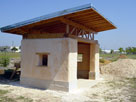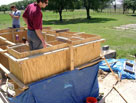| Last semester, Texas A&M construction science students used
rammed earth technology to construct an experimental shed at
the College of Architecture’s new Riverside Campus Prototype
Research Facility, also known as the Architecture Ranch.
Dubbed the “Earth Shack,” the experimental structure
sits on a 13’-8” x 8’ foot print and includes
6’- 6” tall rammed earth walls topped by a sloping
metal roof, which is supported by wood frames. The shack has
two windows and a door and is spanned by bond beams with 15” bearing
on the walls, which are protected by 4’-wide roof overhangs.
Rammed earth is a method of building walls whereby a mixture
of earth is compacted in layers between forms. Each layer of
earth is approximately four inches deep. As each form is filled
and the earth hardens, the formwork is removed and placed for
the next lift. The process continues until the desired wall height
is achieved.
The soil mix, Burt explained, needs to be carefully balanced
between clay, sand and aggregate. The clay and moisture content
of rammed earth, he said, is relatively low compared to that
used for mud brick or other earth building methods.
For details on the Earth Shack experiment and the students’ discoveries,
read Burt’s project report:
http://archone.tamu.edu/archcom/InsideTrack/
PDFs/EarthShackReport.pdf
| |

The Architecture Ranch's new 'Earth Shack'

Computer pre-visualization and design drawing

Construction Science
professor Richard Burt inspects another layer of rammed earth during
the construction of the Architecture Ranch's new Earth Shack

Montage of photos from construction
Larger Images>>
|

